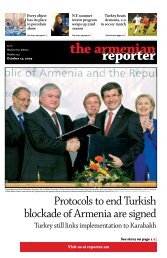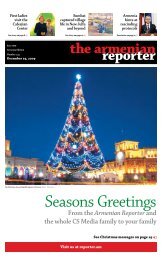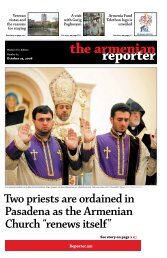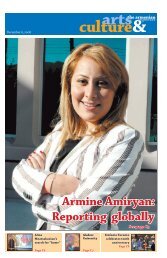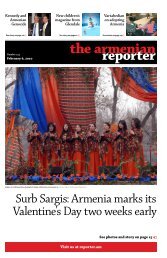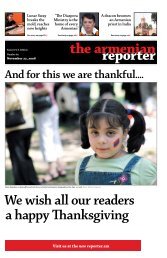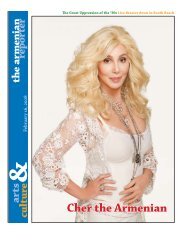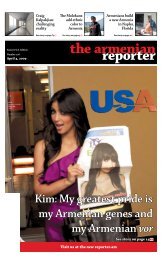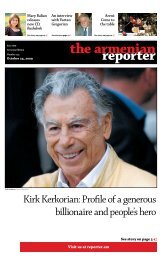Create successful ePaper yourself
Turn your PDF publications into a flip-book with our unique Google optimized e-Paper software.
April 4, 2009<br />
arts<br />
culture<br />
the armenian<br />
&<br />
reporter<br />
<strong>Love</strong> <strong>is</strong> h<strong>is</strong> <strong>religion</strong><br />
Reincarnation, headed by Roland Gasparyan, has created something truly unique in Armenia’s music scene – reggae – and it works. Photo: Vahan Stepanyan.
Celebrating National Poetry Month<br />
by Lory<br />
Bedikian<br />
Every year, since 1996, the month of April<br />
has been recognized as National Poetry<br />
Month, here in the United States. The<br />
Academy of American Poets establ<strong>is</strong>hed<br />
th<strong>is</strong> month-long celebration, which today<br />
<strong>is</strong> a part of events at schools, libraries,<br />
cultural centers, bookstores and even<br />
homes.<br />
If one goes to the Poets.org website,<br />
there <strong>is</strong> an entire section l<strong>is</strong>ting th<strong>is</strong><br />
year’s events alongside much of the h<strong>is</strong>tory<br />
behind it. Some of the purposes<br />
as to why th<strong>is</strong> celebration was created<br />
includes to “Highlight the extraordinary<br />
legacy and ongoing achievement<br />
of American poets” as well as to “Introduce<br />
more Americans to the pleasures of<br />
reading poetry.” The l<strong>is</strong>t of course goes<br />
on and the Academy has been doing a<br />
wonderful service to poetry lovers, old<br />
and new.<br />
It’s been my own hope, for the past<br />
two years, that the “Poetry Matters” column<br />
has been a microcosm of th<strong>is</strong> type<br />
of celebration on a monthly and weekly<br />
bas<strong>is</strong>. A desire to share poetry with all<br />
types of readers, to show an appreciation<br />
for it, has been the catalyst for writing<br />
such a column. My belief <strong>is</strong> that in<br />
all art there <strong>is</strong> some truth that emerges<br />
and never leaves us the same. With poetry<br />
— th<strong>is</strong> form of condensed language,<br />
uttering words with music and color,<br />
with textures and images — one can<br />
read a poet’s intended story or moment<br />
in time which has crystallized into it’s<br />
own language-sculpture on the page.<br />
As <strong>Armenian</strong>s, here in the U.S. and<br />
across the globe, how can we celebrate<br />
National Poetry Month? How can we<br />
use poetry in our daily lives to enhance<br />
the meaning of our experiences and also<br />
to simply find pleasure in the playfulness<br />
of language? Again — and forgive<br />
my sentimentality — it <strong>is</strong> my hope that<br />
th<strong>is</strong> column has ass<strong>is</strong>ted in an ongoing<br />
attempt to celebrate poetry on an ongoing<br />
bas<strong>is</strong> and in an unassuming way.<br />
Well, let’s get to the point then. What<br />
are some ideas? I’ve compiled a small l<strong>is</strong>t,<br />
which should be questioned, changed,<br />
perhaps attempted and perhaps thrown<br />
out, if one can come up with better ideas<br />
of their own. Why not? Basically, it’s a<br />
starting point. It <strong>is</strong> in no way a comprehensive<br />
l<strong>is</strong>t, but merely a few scribbles.<br />
It comes from a love of poetry, a belief in<br />
Lory Bedikian received her MFA in Poetry from the<br />
University of Oregon. Her collection of poetry has<br />
twice been selected as a final<strong>is</strong>t in the Crab Orchard<br />
Series in Poetry Open Competition and twice in<br />
the Crab Orchard Series in Poetry First Book Award<br />
Competition.<br />
<strong>Armenian</strong> <strong>Reporter</strong> Arts & Culture<br />
Copyright © 2009 by <strong>Armenian</strong> <strong>Reporter</strong> llc<br />
All Rights Reserved<br />
Contact arts@reporter.am with announcements<br />
To advert<strong>is</strong>e, write business@reporter.am or<br />
call 1-201-226-1995<br />
Peter Balakian.<br />
th<strong>is</strong> humble and blessed art form. I want<br />
to let poetry matter. My hope <strong>is</strong> that<br />
others will let poetry matter too.<br />
Ways to Celebrate National<br />
Poetry Month<br />
(Th<strong>is</strong> l<strong>is</strong>t <strong>is</strong> not in order of importance or in<br />
some sort of pattern. Try any of these ideas<br />
any day of th<strong>is</strong> month, and even all throughout<br />
the year)<br />
m Subscribe to the <strong>Armenian</strong> Poetry<br />
Project<br />
Th<strong>is</strong> blog has been curated and organized<br />
by Lola Koundakjian since it first appeared<br />
in May of 2006. It has received<br />
over 81,000 hits and 18,200 audio downloads.<br />
Koundakjian writes that “readership<br />
has spread to over 100 countries<br />
where the lonely and the curious reach<br />
out to poetry.” I myself am a subscriber<br />
and it <strong>is</strong> such a joy to receive, almost daily,<br />
poems in <strong>Armenian</strong>, Engl<strong>is</strong>h and French<br />
from poets all throughout time and all<br />
over the world. It’s free and a great way<br />
to support the project <strong>is</strong> to subscribe and<br />
also to make a contribution for th<strong>is</strong> notfor-profit<br />
labor of love. Connect at http://<br />
armenian-poetry.blogspot.com/<br />
m Buy a poetry book, read it and<br />
give the gift of poetry<br />
What I learned from a writer’s conference<br />
I attended years ago <strong>is</strong> that poetry<br />
<strong>is</strong> the least “sold” of the many genres of<br />
literature. For some crazy reason, th<strong>is</strong><br />
has not d<strong>is</strong>couraged me. How wonderful<br />
Left: David<br />
Kherdian. Right: Lola<br />
Koundakjian.<br />
would it be if for poetry month, all of<br />
us bought just one book of poetry each?<br />
With technology nowadays, all one has<br />
to do <strong>is</strong> go to an online bookseller and<br />
before you know it the book <strong>is</strong> in the mail.<br />
Support our contemporary poets like<br />
Peter Balakian, Diana Der-Hovanessian,<br />
Gregory Djanikian, Aram Saroyan, David<br />
Kherdian, Arpine Konyalian Grenier,<br />
William Michaelian, James Baloian and<br />
so many others in <strong>Armenian</strong> and elsewhere.<br />
Demand poetry. Let the presses<br />
know we’re hungry for the creations of<br />
our bards.<br />
m Support a bookstore<br />
In Los Angeles, we’re fortunate enough<br />
to have both Abril Bookstore and Sardarabad<br />
Bookstore and both stores offer<br />
so much in terms of books, music, cultural<br />
items and much, much more. What<br />
makes me so sad <strong>is</strong> to see (sometimes) the<br />
books of our greatest poets just sitting on<br />
the shelves. How wonderful would it be<br />
if they suddenly ran out and some publ<strong>is</strong>her<br />
or press somewhere had to print<br />
more copies of Vahan Tekeyan’s or Sylva<br />
Gaboudigian’s works in <strong>Armenian</strong> or in<br />
translation? You know the holidays that<br />
are fast approaching. Choose one poet<br />
or collection and wrap that book up for<br />
your mother, father, brother, s<strong>is</strong>ter and<br />
watch as a light shines over their face<br />
when they read a line that does nothing<br />
else but remind them of something w<strong>is</strong>e,<br />
something beautiful. Connect at http://<br />
www.abrilbooks.com/ and http://sardarabad.org/<br />
m Read to children<br />
Children need to be read to. We all know<br />
th<strong>is</strong>. Whether you read to them from an<br />
anthology of <strong>Armenian</strong> poetry or the<br />
rhyming, silly wonders of Dr. Seuss classics,<br />
it instills in them the wonderful<br />
habit of reading and investing in their<br />
own self-education. Take them to a bookstore,<br />
a library, or a church bookstore and<br />
let them see the wonderful covers and<br />
words. Teach them about the importance<br />
of our poets and what they meant to you<br />
growing up. Tell them stories of the first<br />
poems you memorized when you went to<br />
<strong>Armenian</strong> school, or the first poems you<br />
read when you found out what poetry<br />
was.<br />
m Etc.<br />
Th<strong>is</strong> <strong>is</strong> my favorite category of all; because<br />
it’s where I allow myself to give you<br />
a myriad of ideas that I believe would be<br />
not only educational, but also fun. Go<br />
to events th<strong>is</strong> month and, as much as<br />
you can, in the future. For example, if<br />
you’re in the east coast, make it an outing<br />
and go to a “Gartal” event coordinated<br />
by Nancy Agabian at the Cornelia Street<br />
Café in Greenwich Village. If you’re in Los<br />
Angeles remember that Abril and Sardarabad<br />
cons<strong>is</strong>tently host events, often<br />
with poets on board. Look up the events<br />
at your local libraries. Plan a poetry event<br />
of your own! Get a few friends together,<br />
choose a location, let others know and<br />
read your favorite poems. Subscribe to<br />
newspapers, literary magazines and any<br />
journal that showcases poets, poetry and<br />
writers. Last, but not least, try your hand<br />
at poetry. Sure, not everyone who loves<br />
running, will become an Olympic medal<strong>is</strong>t,<br />
just as not everyone who writes<br />
a poem, will necessarily become a publ<strong>is</strong>hed<br />
author. Poetry <strong>is</strong> a universal art<br />
form and it’s appreciation and use can<br />
create miracles. Happy National Poetry<br />
Month, today and every day. f<br />
Your news goes right here<br />
See an “ian” on the credits? Watch a<br />
Hye on your local news? Write the <strong>Reporter</strong>,<br />
and we’ll get crackin’ to profile<br />
the son or daughter of Hayk in an upcoming<br />
<strong>is</strong>sue.<br />
Point and click an ‘e’ to<br />
arts@reporter.am (dot am on the<br />
‘net <strong>is</strong> for all things <strong>Armenian</strong>!).<br />
connect:<br />
arts@reporter.am<br />
C2 <strong>Armenian</strong> <strong>Reporter</strong> Arts & Culture April 4, 2009
Corridor, cibachrome<br />
print mounted on<br />
aluminum, 30” x<br />
40.” Photos: www.<br />
kalpakjian.com<br />
Craig Kalpakjian: challenging reality<br />
Trompe l’Oeil for the 21st<br />
Century?<br />
by<br />
Chr<strong>is</strong>topher<br />
Atamian<br />
We are used to trusting “reality,” at least<br />
when it comes to photographs or what<br />
we imagine to be photographs. If you<br />
want to show someone what something<br />
looks like or keep a record of daily reality,<br />
photographs carry an unimpeachable authority,<br />
more so than any other art form<br />
or method of representation, apart from<br />
documentary film perhaps. In photojournal<strong>is</strong>m<br />
especially, the expectation of<br />
strict ver<strong>is</strong>imilitude <strong>is</strong> most pronounced.<br />
Yet as Susan Sontag noted in On Photography,<br />
even Farm Security Admin<strong>is</strong>tration<br />
photographers such as Dorothea<br />
Lange posed their subjects according to<br />
certain preconceived notions of what<br />
they thought poor farm people to be or<br />
look like: the results of their work could<br />
not, in a sense, have turned out any differently.<br />
Nothing it would seem <strong>is</strong> ever<br />
truly, exactly as it appears.<br />
Brooklyn-based art<strong>is</strong>t Craig Kalpakjian<br />
takes the illusion of ver<strong>is</strong>imilitude<br />
a few steps further. He creates entirely<br />
computer-generated images that look<br />
like photographs but are, in fact, nothing<br />
of the kind, putting a new v<strong>is</strong>ualaesthetic<br />
spin on D.H. Lawrence’s observation<br />
that “An illusion which <strong>is</strong> a real<br />
experience <strong>is</strong> worth having.” Kalpakjian’s<br />
pieces are not photos at all, as no<br />
camera or camera-like device has been<br />
used to produce them. They are actually<br />
giclée or inkjet prints, often mounted<br />
on plexiglas. The term giclée, taken<br />
from the French for “to squirt,” refers<br />
to prints made from a digital source using<br />
ink jet printers. The forty-seven yearold<br />
Kalpakjian creates these computerdesigned<br />
and generated images with an<br />
architectural program called “Form Z.”<br />
The results question the relationship between<br />
the real and the virtual in exciting<br />
and dramatic ways and remind us that<br />
healthy skeptic<strong>is</strong>m <strong>is</strong> as good an aesthetic<br />
policy as any. Here it’s not your<br />
eyes playing tricks on you, but the art<strong>is</strong>t<br />
himself!<br />
At the recent show at the Metropolitan<br />
Museum of Art Reality Check: Truth<br />
and Illusion in Contemporary Photography,<br />
a single image, Kalpakjian’s 1995 Corridor,<br />
encapsulates many of h<strong>is</strong> formal<br />
and aesthetic concerns. The image <strong>is</strong> just<br />
that: a lit, white curved corridor devoid<br />
of objects and people. In fact, nothing<br />
could be more mundane. Kalpakjian’s<br />
ant<strong>is</strong>eptic corridor possesses a futur<strong>is</strong>tic<br />
sci-fi aura, a telling comment on the<br />
modern world and workplace and the<br />
spaces that we imagine, build, and then<br />
work in and inhabit. In fact, not only<br />
<strong>is</strong> the photo in question not a photo,<br />
but the corridor <strong>is</strong> not a corridor, nor<br />
does it necessarily refer to a particular<br />
corridor that Kalpakjian has seen in the<br />
past. It’s any corridor and every corridor,<br />
or as Jean Baudrillard might have put<br />
it, a simulacrum of a corridor, detached<br />
from any actual referent, place, object,<br />
or time except for those found in the<br />
art<strong>is</strong>t’s fertile imagination. The rest of<br />
the photographs in the exhibit also challenge<br />
our notions of what <strong>is</strong> real and<br />
what <strong>is</strong> simulated, including staged scenarios<br />
and constructed environments<br />
(and conversely real environments that<br />
look simulated or fake) by art<strong>is</strong>ts such<br />
as James Casebere, Gregory Crewdson,<br />
and Vik Muniz. Yet it’s Kalpakjian’s<br />
piece, by the very nature of its seeming<br />
simplicity (and hidden complexity) that<br />
perhaps seduces most.<br />
It would be too easy to conclude that<br />
IT’S KEF TIME<br />
“I’m in <strong>Love</strong> With the Modern World,” inkjet print<br />
mounted on plexiglass, 48” x 64”<br />
Kalpakjian <strong>is</strong> making some sort of postmodern<br />
comment on alienation or solitude:<br />
h<strong>is</strong> work <strong>is</strong> to o clever for that and<br />
almost sidesteps th<strong>is</strong> <strong>is</strong>sue altogether.<br />
In Kalpakjian’s corporate interiors, we<br />
not only lose any relation or sense of<br />
difference between the real and the simulated,<br />
we even begin to question the<br />
nature of the simulation itself. Are they<br />
in fact reconstructions of past images<br />
engraved in Kalpakjian’s mind? And if<br />
Continued on page C5 m<br />
<strong>Armenian</strong> <strong>Reporter</strong> Arts & Culture April 4, 2009<br />
C3
<strong>Armenian</strong> reggae’s Gasparyan: <strong>Love</strong> <strong>is</strong> h<strong>is</strong> <strong>religion</strong><br />
The Reincarnation<br />
frontman d<strong>is</strong>cusses<br />
faith, reggae, and a world<br />
without borders<br />
by Nyree Abrahamian<br />
Jan Rastaman – two words you probably<br />
never thought you’d see side by side.<br />
But for reggae band Reincarnation, “Jan<br />
Rastaman,” the name of one of their hit<br />
songs, has become something of a motto,<br />
a symbol of their melded sound. <strong>Armenian</strong><br />
reggae <strong>is</strong> not the most likely fusion,<br />
and most people who hear of it for the<br />
first time are skeptical, but Reincarnation,<br />
headed by Roland Gasparyan, has<br />
created something truly unique, and it<br />
works. After seeing them perform live<br />
for the first time at Yerevan’s Avantgarde<br />
Folk Music Club, I was amazed that I<br />
hadn’t focused for a second on the fact<br />
that they were singing in <strong>Armenian</strong> about<br />
“Jah love,” but had gotten right into the<br />
groove, swaying along and partaking in<br />
the good vibes all around.<br />
Their music <strong>is</strong> as laid back as it gets,<br />
but the band members are driven, focused<br />
and have a lot to look forward to.<br />
They recently headed the soundtrack of<br />
the popular film, “Taxi Eli Lav A,” are<br />
currently recording their second reggae<br />
album, and are gearing up for a tour<br />
of all the regions of Armenia. But first,<br />
they will be in Los Angeles for the <strong>Armenian</strong><br />
Music Awards on May 2.<br />
Gasparyan <strong>is</strong> looking forward to the<br />
v<strong>is</strong>it. “We’ll see what they give us, or what<br />
they don’t give us,” he says, in h<strong>is</strong> typical<br />
easygoing fashion. “What’s important<br />
<strong>is</strong> that it’s a fun night, and we’ll get a<br />
chance to meet lots of other <strong>Armenian</strong><br />
art<strong>is</strong>ts.” He hopes that the whole band<br />
will be able to go so that they can give a<br />
few performances in Los Angeles. “People<br />
have been asking us to perform there for<br />
a while now, and we’d love to if given the<br />
chance,” says the affable lead singer.<br />
Reincarnation, headed by<br />
Roland Gasparyan, has<br />
created something truly<br />
unique, and it works.<br />
Roland Gasparyan started Reincarnation<br />
eight years ago as a metal band.<br />
“Over the years, our sound and our style<br />
have changed a lot,” he says. “We went<br />
from metal, to punk, and then in 2006,<br />
the band reformed with all the current<br />
members, and we went into reggae and<br />
ska.” They quickly recorded their first<br />
reggae album, “Janfida to Jamaica 60<br />
km,” and started performing in Yerevan<br />
clubs. Their live shows are invigorating,<br />
with good vibes, great music, and smiles<br />
all around. By the end of their set, not a<br />
single person can be found seated.<br />
In its current incarnation, Reincarnation<br />
cons<strong>is</strong>ts of seven members, Gasparyan<br />
on guitar and lead vocals, Hayk<br />
Khazaryan on trumpet, David Minasian<br />
on trombone, Marek Zaborsky on drums,<br />
Arthur Hovakimyan on keyboards, David<br />
Esayan on bass and Arthur Grigoryan<br />
on saxaphone. “The band has evolved<br />
a lot, so along the way, different members<br />
have come and gone,” says Gasparyan,<br />
ins<strong>is</strong>ting that there was never any<br />
bad blood, but that people moved on<br />
for different personal reasons. “But with<br />
the group we have now, something has<br />
just clicked,” he adds. “I don’t think the<br />
band members will change – if anything,<br />
we will keep growing. I can proudly say<br />
that the people I work with are firstly<br />
my great friends, and that they are also<br />
excellent musicians.”<br />
Gasparyan <strong>is</strong> the only member of<br />
the band who <strong>is</strong> not classically trained,<br />
though you’d never guess it considering<br />
he composes most of their music and all<br />
of their lyrics. I tell him that training or<br />
no training, he clearly has a great ear for<br />
music, to which he shrugs and replies,<br />
“It’s from God. God gives us everything.”<br />
He speaks a lot about faith and tries<br />
to center h<strong>is</strong> life around a strong religious<br />
base, though not in the traditional<br />
sense. “I’m very interested in Rastafari-<br />
Continued on page C5 m<br />
CD cover.<br />
Roland Gasparyan.<br />
Photo: Vahan<br />
Stepanyan.<br />
C4 <strong>Armenian</strong> <strong>Reporter</strong> Arts & Culture April 4, 2009
Craig Kalpakjian: challenging reality<br />
n Continued from page C3<br />
so, why does he choose to share these<br />
particular memories of these particular<br />
corridors or shapes? In a sense, by simulating<br />
these shapes and office spaces,<br />
Kalpakjian makes them hyper-real: we<br />
pay more attention to every detail, to<br />
see if we can find a fault in them or understand<br />
their almost surreal attraction.<br />
But then in yet another v<strong>is</strong>ually ironic<br />
tw<strong>is</strong>t, Kalpakjian’s illusions prove to be<br />
illusory as well: upon closer inspection,<br />
the works are far from perfect. They are<br />
neater, “cleaner” as Kalpakjian notes,<br />
than real-life images and they lack the<br />
imperfections of a cracked wall or the<br />
detail on a typical “real-world” ceiling<br />
or hallway.<br />
Kalpakjian has a wry sense of humor,<br />
moreover, positioning bullet holes in the<br />
corner of one piece and knocking over a<br />
garbage can in another. Th<strong>is</strong>, combined<br />
with provocative titles—an image of<br />
two buildings one behind the other that<br />
recall Chr<strong>is</strong>tian de Portzemparc’s Bibliotèque<br />
Nationale in Par<strong>is</strong> titled “--”) create<br />
a back story to h<strong>is</strong> pieces, or as Kalpakjian<br />
notes a “double back story.” The<br />
story that goes along with creating the<br />
piece doubles up with the story within<br />
the piece, creating a creative-performative<br />
m<strong>is</strong>e-en-abyme of sorts: “It’s the<br />
creative-performative act that changes<br />
a piece,” notes Kalpakjian: “And it’s ok if<br />
it’s not immediately readable…”<br />
In another piece titled I’m In <strong>Love</strong> with<br />
the Modern World (2005), a set of broken<br />
factory windows creates an aesthetic of<br />
irony: the image <strong>is</strong> in fact sad and unremarkable,<br />
a place most people, one assumes,<br />
would avoid rather than run to.<br />
Yet a beautiful sun can be seen in the<br />
upper left-hand corner and suddenly<br />
one notices the beauty of the patterns<br />
created by the holes in the glass and by<br />
the windows themselves. And then one<br />
Are You Feeling Better Now? Inkjet print, 36” x 48 “<br />
realizes that image and title don’t (need<br />
to) concord or overlap: the art<strong>is</strong>t d<strong>is</strong>tances<br />
himself from h<strong>is</strong> own performative<br />
act and creates a playful semiotic<br />
gap between naming and representing,<br />
between the referred-to signified and<br />
the signifying name.<br />
Kalpakjian, who currently teaches at<br />
Baltimore’s MICA, grew up in Long Island<br />
and majored in art h<strong>is</strong>tory at the<br />
University of Pennsylvania, before moving<br />
to New York City where he began<br />
to work as an art<strong>is</strong>t in the 1990’s. H<strong>is</strong><br />
present work evolved in a fascinating<br />
and somewhat linear fashion. In the 90’s<br />
Kalpakijian worked mainly as a sculptor,<br />
constructing free-standing pieces such<br />
as h<strong>is</strong> “Deal Tray” made from a bulletproof<br />
plexiglass screen and a tin change<br />
tray. Th<strong>is</strong> piece recreates the apparatus<br />
that bank tellers sit behind when they<br />
hand money over to clients. In a somewhat<br />
later piece, Kalpakjian built a waiting<br />
line like the ones that one stands<br />
in at the cinema. Then using computer<br />
simulation technology, he recreated th<strong>is</strong><br />
maze-like installation on-screen and animated<br />
it so that one could walk through it<br />
virtually, as in a video game. Perspective<br />
and point-of-view become important<br />
considerations here. The work was also<br />
the precursor to Kalpakjian’s current interest<br />
in creating entirely computer-generated,<br />
photography-like work. The art<strong>is</strong>t<br />
has always been intrigued by v<strong>is</strong>ual<br />
puns and rebuses. Kalpakjian placed a<br />
screen flat on a floor, facing up at the<br />
ceiling. On it he simulated the motion of<br />
a camera so that when a viewer looked<br />
down at it he or she had the impression<br />
of following a camera around that was<br />
videotaping the scene and the people<br />
looking down on it.<br />
One of the most curious and stimulating<br />
aspects of Kalpakjian’s work lies<br />
in h<strong>is</strong> actual selection of objects and<br />
scenes: empty offices, staircases, hallways<br />
and broken windows. The art<strong>is</strong>t<br />
notes that friends have suggested that<br />
he <strong>is</strong> perhaps fascinated by these environments<br />
because he has never had to<br />
actually work in a modern, ant<strong>is</strong>eptic<br />
office environment. The former observation<br />
notwithstanding, Kalpakjian’s<br />
images intuit a post-human world or<br />
perhaps a world simply devoid of life<br />
Shoegazer. Computer generated animation on DVD, dimensions variable.<br />
altogether. A post-nuclear holocaust<br />
simulation or simply an empty office<br />
before and after someone stepped in or<br />
out of it? There <strong>is</strong> something d<strong>is</strong>tinctly<br />
Ballardian about the bleak yet compelling<br />
images that Kalpakjian creates. In<br />
fact, Kalpakjian readily acknowledges<br />
J.G. Ballard’s influence, as well as Fredric<br />
Jameson’s “Archeologies of the Future,”<br />
which looks at the relationship<br />
and overlap between utopias and science<br />
fiction.<br />
It’s one thing of course to blithely follow<br />
a theoretical or aesthetic whimsy and<br />
see where it leads, sometimes succeeding<br />
in fooling the viewer. It’s quite another<br />
to achieve the level of fascinating v<strong>is</strong>ual<br />
trickery and playfulness present in Kalpakjian’s<br />
work. We are delighted by the<br />
empty spaces and fearful of them as well.<br />
We stare at them bemused and intrigued,<br />
and in th<strong>is</strong> hyperreal v<strong>is</strong>ual universe, we<br />
half expect Hal from 2001: A Space Odyssey<br />
to begin speaking to us from beyond<br />
the picture frame.<br />
f<br />
connect:<br />
www.kalpakjian.com<br />
<strong>Armenian</strong> reggae’s Gasparyan: <strong>Love</strong> <strong>is</strong> h<strong>is</strong> <strong>religion</strong><br />
Reincarnation performing at Fete de la Musique 2008 in Yerevan. Left to right: Roland Gasparyan,<br />
David Minasian, Hayk Khazaryan, David Esayan.<br />
<strong>Armenian</strong> <strong>Reporter</strong> Arts & Culture April 4, 2009<br />
n Continued from page C4<br />
an<strong>is</strong>m, but for me, there <strong>is</strong> something<br />
that comes before everything,” says the<br />
singer. “<strong>Love</strong> <strong>is</strong> my <strong>religion</strong>. To me, all<br />
faiths are one… Anything that preaches<br />
love <strong>is</strong> my <strong>religion</strong>.”<br />
“Janfida to Jamaica 60 km” was a reggae/ska<br />
album, but Reincarnation’s<br />
upcoming album, which they hope to<br />
release as early as th<strong>is</strong> fall, takes it a<br />
step further, merging <strong>Armenian</strong> music,<br />
gypsy music, and more regional sounds<br />
with a strong reggae element. “We are<br />
anxious to see our fans’ reactions,” says<br />
Gasparyan, “Because I can honestly say<br />
that in th<strong>is</strong> album, we found our own<br />
sound. We are telling <strong>Armenian</strong> stories<br />
through a unique voice.”<br />
While he <strong>is</strong> a strong advocate for “universal<br />
citizenship”, adhering to the notion<br />
that regardless of where we are born, “the<br />
world <strong>is</strong> our birthplace – we have no borders,”<br />
Gasparyan ins<strong>is</strong>ts on the importance<br />
of singing in <strong>Armenian</strong>. “Our music <strong>is</strong> in<br />
<strong>Armenian</strong> for one reason – it’s for <strong>Armenian</strong>s,”<br />
he says. “I really want our people to<br />
love and respect each other and all people.<br />
There <strong>is</strong> a lack of love nowadays, and in my<br />
opinion, our music can help bring about<br />
more love. Music <strong>is</strong> such a strong tool. It<br />
can bring about a revolution.”<br />
Besides, as a musician, he understands<br />
well that there <strong>is</strong> something<br />
genuine about singing in your mother<br />
tongue that carries through, transcending<br />
language barriers. “I don’t speak<br />
Engl<strong>is</strong>h that well,” he says, “But believe<br />
me, there are certain songs that hit my<br />
heart. Without knowing the words, I<br />
know exactly what they’re about.”<br />
Taken from “War”, a song off their 2006<br />
album “Janfida to Jamaica 60 km”, here’s<br />
a sample of what Reincarnation <strong>is</strong> about:<br />
Ari khosenk menk mi lezvov<br />
Come, let’s speak in one language<br />
Ari yerkenk menk mi khoskov<br />
Come, let’s sing in one word<br />
Ari badmenk menk polorin<br />
Come, let’s tell everyone<br />
Jah’n sirum e amenkin<br />
Jah loves us all<br />
f<br />
connect: www.reincarnation.am<br />
C5
Program Grid<br />
6 – 12 April<br />
EST PST<br />
10:00 PM 1:00 AM<br />
11:00 PM 2:00 AM<br />
11:30 PM 2:30 AM<br />
12:00 AM 3:00 AM<br />
1:00 AM 4:00 AM<br />
2:00 AM 5:00 AM<br />
2:30 AM 5:30 AM<br />
3:00 AM 6:00 AM<br />
3:30 AM 6:30 AM<br />
4:00 AM 7:00 AM<br />
4:30 AM 7:30 AM<br />
5:00 AM 8:00 AM<br />
5:30 AM 8:30 AM<br />
6:00 AM 9:00 AM<br />
6:30 AM 9:30 AM<br />
7:00 AM 10:00 AM<br />
7:30 AM 10:30 AM<br />
8:00 AM 11:00 AM<br />
8:30 AM 11:30 AM<br />
9:30 AM 12:30 PM<br />
10:00 AM 01:00 PM<br />
10:30 AM 01:30 AM<br />
11:00 AM 02:00 PM<br />
12:00 PM 03:00 PM<br />
12:30 PM 03:30 PM<br />
01:00 PM 04:00 PM<br />
01:30 PM 04:30 PM<br />
02:00 PM 05:00 PM<br />
02:30 PM 05:30 PM<br />
03:00 PM 06:00 PM<br />
03:30 AM 06:30 AM<br />
04:00 PM 07:00 PM<br />
04:30 AM 07:30 AM<br />
05:00 PM 08:00 PM<br />
05:30 PM 08:30 PM<br />
06:00 PM 09:00 PM<br />
06:30 PM 09:30 PM<br />
07:00 PM 10:00 PM<br />
07:30 PM 10:30 PM<br />
08:00 PM 11:00 PM<br />
08:30 PM 11:30 PM<br />
09:00 PM 12:00 AM<br />
09:30 PM 12:30 AM<br />
6 April 7 April 8 April 9 April 10 April 11 April<br />
Monday Tuesday Wednesday Thursday Friday Saturday<br />
Deal or No Deal<br />
Fathers & Sons<br />
<strong>Love</strong> E Lee<br />
7 Mekhq (Serial)<br />
TV Duel<br />
Tele Kitchen<br />
Mult<br />
Yo Yo<br />
News<br />
Bari Luys<br />
with Stepan Partamian<br />
Directions With<br />
Rafi Manoukian<br />
Bari Luys<br />
Hayer<br />
Bari Aravod<br />
News<br />
Yerkvoryak<br />
(Serial)<br />
7 Mekhq (Serial)<br />
Tele Kitchen<br />
Mult<br />
YO YO<br />
When Stars are Dancing<br />
Live from America<br />
News<br />
CLONE<br />
(Serial)<br />
Unlucky Happiness<br />
(Serial)<br />
Vrijarou<br />
(Serial)<br />
News<br />
Gyanki Keene<br />
(Serial)<br />
Tonight Show<br />
11 (Serial)<br />
News<br />
Bari Luys with Stepan<br />
Partamian<br />
CLONE (Serial)<br />
Vrijarou<br />
(Serial)<br />
Yerkvoryak (Serial)<br />
7 Mekhq (Serial)<br />
Unlucky Happiness<br />
(Serial)<br />
Tele Kitchen<br />
Mult<br />
Yo Yo<br />
News<br />
Bari Luys<br />
with Stepan Partamian<br />
Unlucky Happiness<br />
(Serial)<br />
Bari Luys<br />
Hayer<br />
Bari Aravod<br />
News<br />
Yerkvoryak<br />
(Serial)<br />
7 Mekhq (Serial)<br />
Tele Kitchen<br />
Mult<br />
YO YO<br />
When Stars are Dancing<br />
Live from America<br />
News<br />
CLONE<br />
(Serial)<br />
Unlucky Happiness<br />
(Serial)<br />
Vrijarou<br />
(Serial)<br />
News<br />
Gyanki Keene<br />
(Serial)<br />
Tonight Show<br />
11 (Serial)<br />
News<br />
Bari Luys with<br />
Stepan Partamian<br />
CLONE (Serial)<br />
Vrijarou<br />
(Serial)<br />
Yerkvoryak (Serial)<br />
7 Mekhq (Serial)<br />
Unlucky Happiness<br />
(Serial)<br />
Tele Kitchen<br />
Mult<br />
Yo Yo<br />
News<br />
Bari Luys<br />
with Stepan Partamian<br />
Unlucky Happiness<br />
(Serial)<br />
Bari Luys<br />
Hayer<br />
Bari Aravod<br />
News<br />
Yerkvoryak<br />
(Serial)<br />
7 Mekhq (Serial)<br />
Tele Kitchen<br />
Mult<br />
YO YO<br />
When Stars are Dancing<br />
Live from America<br />
News<br />
CLONE<br />
(Serial)<br />
Unlucky Happiness<br />
(Serial)<br />
Vrijarou<br />
(Serial)<br />
News<br />
Gyanki Keene<br />
(Serial)<br />
Tonight Show<br />
11 (Serial)<br />
News<br />
Bari Luys with<br />
Stepan Partamian<br />
CLONE (Serial)<br />
Vrijarou<br />
(Serial)<br />
Yerkvoryak (Serial)<br />
7 Mekhq (Serial)<br />
Unlucky Happiness<br />
(Serial)<br />
Tele Kitchen<br />
Mult<br />
Yo Yo<br />
News<br />
Bari Luys<br />
with Stepan Partamian<br />
Unlucky Happiness<br />
(Serial)<br />
Bari Luys<br />
Hayer<br />
Bari Aravod<br />
News<br />
Yerkvoryak<br />
(Serial)<br />
7 Mekhq (Serial)<br />
Tele Kitchen<br />
Mult<br />
YO YO<br />
douk Yeteroum Ek<br />
Lragroghakan<br />
News<br />
CLONE<br />
(Serial)<br />
Unlucky Happiness<br />
(Serial)<br />
Vrijarou<br />
(Serial)<br />
News<br />
Pakhousd<br />
(Serial)<br />
Yere 1<br />
Live From America<br />
News<br />
Bari Luys with<br />
Stepan Partamian<br />
CLONE (Serial)<br />
Vrijarou<br />
(Serial)<br />
Yerkvoryak (Serial)<br />
7 Mekhq (Serial)<br />
Unlucky Happiness<br />
(Serial)<br />
Tele Kitchen<br />
Mult<br />
Yo Yo<br />
News<br />
Bari Luys<br />
with Stepan Partamian<br />
Unlucky Happiness<br />
(Serial)<br />
Bari Luys<br />
Hayer<br />
Bari Aravod<br />
News<br />
Yerkvoryak<br />
(Serial)<br />
7 Mekhq (Serial)<br />
Tele Kitchen<br />
Mult<br />
YO YO<br />
douk Yeteroum Ek<br />
Lragroghakan<br />
News<br />
CLONE<br />
(Serial)<br />
Unlucky Happiness<br />
(Serial)<br />
Vrijarou<br />
(Serial)<br />
News<br />
Pakhousd<br />
(Serial)<br />
Cool Program<br />
Live From America<br />
News<br />
Bari Luys with<br />
Stepan Partamian<br />
CLONE (Serial)<br />
Vrijarou<br />
(Serial)<br />
Yerkvoryak (Serial)<br />
7 Mekhq (Serial)<br />
Unlucky Happiness<br />
(Serial)<br />
Tele Kitchen<br />
Mult<br />
Yo Yo<br />
News<br />
Bari Luys<br />
with Stepan Partamian<br />
Unlucky Happiness<br />
(Serial)<br />
D<strong>is</strong>covery<br />
Century<br />
Armenia Diaspora<br />
Fathers & Sons<br />
News<br />
Yerkvoryak<br />
(Serial)<br />
7 Mekhq (Serial)<br />
Tele Kitchen<br />
Mult<br />
YO YO<br />
Yere 1 (ye:re:van)<br />
Cool Program<br />
News Editorial<br />
D<strong>is</strong>covery<br />
Century<br />
Blef<br />
Deal or No Deal<br />
Armenia Diaspora<br />
Vrijarou 1<br />
Vrijarou 2<br />
Vrijarou 3<br />
Vrijarou 4<br />
Vrijarou 5<br />
12 April<br />
Sunday<br />
Deal or No Deal<br />
Century<br />
Armenia Diaspora<br />
Yerkvoryak (Serial)<br />
7 Mekhq (Serial)<br />
D<strong>is</strong>covery<br />
Century<br />
Armenia Diaspora<br />
Fathers & Sons<br />
News<br />
Bari Luys<br />
with Stepan Partamian<br />
Fathers & Sons<br />
<strong>Armenian</strong> Teletime<br />
<strong>Armenian</strong><br />
Movie<br />
Yere 1 (ye:re:van)<br />
Cool Program<br />
7 Mekhq (Serial)<br />
TV Duel<br />
<strong>Love</strong> E Lee<br />
A Drop Of Honey<br />
Deal or No Deal<br />
Blef<br />
My Big, Fat <strong>Armenian</strong><br />
Wedding<br />
Directions With<br />
Rafi Manoukian<br />
When Stars<br />
Are Dancing<br />
CUBE<br />
Doing time with William Saroyan<br />
by Chr<strong>is</strong>topher Atamian<br />
It would be hard to read the <strong>Armenian</strong><br />
press and not be aware that 2008 marked<br />
the one hundredth anniversary of William<br />
Saroyan’s birth. A seemingly endless<br />
series of readings, performances and<br />
commemorations took place last year in<br />
the diaspora and in Armenia. In Yerevan,<br />
a statue of Saroyan was unveiled, putting<br />
him in the elite company of art<strong>is</strong>ts such<br />
as Aram Khatchaturian and Yegh<strong>is</strong>hé<br />
Charents. The Republic of Armenia <strong>is</strong>sued<br />
a limited series of Saroyan stamps,<br />
even though the writer was born seven<br />
thousand miles away in Fresno, California.<br />
Even UNESCO joined in the fray,<br />
making 2008 the official year of Saroyan.<br />
Ask anyone to name a great <strong>Armenian</strong><br />
writer and at least every second answer<br />
will be the same: William Saroyan. I must<br />
admit to having always found th<strong>is</strong> fascination<br />
with Saroyan puzzling, as I had<br />
never once read a Saroyan short story or<br />
play in all my years of schooling or later<br />
on in college or film school. And in my<br />
many years of attending Broadway and<br />
off-Broadway plays, I had never seen a<br />
Saroyan play staged in New York or elsewhere.<br />
At the request of my colleague Bianca<br />
Bagatourian, I took part in th<strong>is</strong> celebration<br />
of all things Saroyan, co-producing<br />
a reading of the rarely-performed play<br />
A Lost Child’s Fireflies at the Ohio Theater<br />
in Soho with the <strong>Armenian</strong> Dramatic<br />
Art<strong>is</strong>ts Alliance. Fireflies <strong>is</strong> a sweet,<br />
simple play that recounts the love and<br />
lives of a group of childhood friends in<br />
the small Pennsylvania town of Sibbald.<br />
Directed by Michael Barakiva and acted<br />
to perfection by a stellar cast of actors,<br />
the reading was a great success. Yet as<br />
lovely as Fireflies may be, it certainly<br />
doesn’t possess any of the complexity<br />
or drama of a Chekhov or Ibsen play,<br />
or even the attention to language of<br />
some contemporary playwrights such<br />
as Tom Stoppard or David Mamet. It<br />
simply recounts the lives of the Fancher<br />
and Bonafus clans; who left Sibbald and<br />
who remained; who married whom and<br />
how they come to view the choices they<br />
make. Dramatic tension <strong>is</strong> all but absent,<br />
psychological unfolding nonex<strong>is</strong>tent.<br />
The Saroyan cult<br />
And so after the reading had come and<br />
gone, I remained puzzled by the intensity<br />
of Saroyan’s continued popularity<br />
among <strong>Armenian</strong>s, especially in the diaspora.<br />
I read many of h<strong>is</strong> plays, poems<br />
and short stories and still I couldn’t see<br />
what the fuss was all about. The Saroyan<br />
cult was all the more surpr<strong>is</strong>ing<br />
given the fact that quite a few <strong>Armenian</strong><br />
writers—Hagop Oshagan, Nigoghos<br />
Sarafian, Costan Zarian, and Zabel<br />
Yessyan all come to mind—are clearly<br />
more nuanced and important. But then<br />
their work has not been translated into<br />
Engl<strong>is</strong>h (for the most part) and they are<br />
more difficult to read and interpret. Saroyan<br />
<strong>is</strong> for better or worse the most successful<br />
Engl<strong>is</strong>h language writer in the<br />
<strong>Armenian</strong> world, Dikran Kouyoumdjian<br />
notwithstanding. Outside the <strong>Armenian</strong><br />
world however, Saroyan has for all<br />
practical purposes d<strong>is</strong>appeared. On the<br />
American literary scene he <strong>is</strong> considered<br />
slightly precious, old fashioned and dated.<br />
Even h<strong>is</strong> most famous works The Daring<br />
Young Man on The Flying Trapeze and<br />
The Human Comedy have not stood the<br />
test of time and are rarely performed.<br />
In recent years, The Cave Dwellers was<br />
produced in 2002 at The Schoolhouse<br />
Theater and again in 2007 at The Pearl to<br />
lousy reviews. The Time of Your Life—for<br />
which Saroyan was awarded and turned<br />
down the Pulitzer in 1940—was put on<br />
at the Finborough in London in 2008.<br />
Critics panned the play, though in th<strong>is</strong><br />
case they seemed to blame its failure on<br />
the director’s lack of imagination.<br />
To a certain extent the Academy’s<br />
judgment <strong>is</strong> not false: there <strong>is</strong> something<br />
facile and oversimplified about Saroyan’s<br />
work. He churned out literally hundreds<br />
of plays, some of which were truly<br />
dreadful. The over-reliance in h<strong>is</strong> prose<br />
on the anecdote and the short sentence<br />
was whimsical but shallow as well. The<br />
great Russian theor<strong>is</strong>t Mikhail Bakhtin<br />
observed that the novel in particular<br />
needed to be both dialogical, meaning<br />
that it engaged works by other writers<br />
previously completed and heteroglossic,<br />
meaning that it should engage more<br />
than one voice or point-of-view. Writing,<br />
one might add, (especially in theater)<br />
needs a strong sense of conflict or drama.<br />
Yet Saroyan seems to avoid conflict and<br />
multiple points-of-view at all costs. In<br />
both h<strong>is</strong> plays and novels he tends to just<br />
string scenes along as if plot and tension<br />
were secondary considerations, if at all.<br />
The smile of a sage?<br />
I recently came upon Places Where I’ve<br />
done Time, publ<strong>is</strong>hed in 1972 by Dell.<br />
Th<strong>is</strong> particular copy sports a wonderful<br />
picture of Saroyan on the cover in white<br />
shirt and black suit, tipping head and<br />
hat forward, a knowing smile radiating<br />
from under h<strong>is</strong> thick mustache. Whether<br />
it’s the smile of a sage or that of a trickster<br />
<strong>is</strong> up for d<strong>is</strong>cussion. Th<strong>is</strong> particular<br />
copy most certainly belonged to my father,<br />
who was both an avid reader and a<br />
huge Saroyan fan while he was alive. The<br />
slim volume (182 pages) <strong>is</strong> composed of<br />
68 anecdotes, each one detailing a place<br />
that Saroyan either lived in, worked in<br />
or v<strong>is</strong>ited in the course of h<strong>is</strong> life. Here<br />
too the anecdote <strong>is</strong> king to the detriment<br />
of any type of analytic exposition.<br />
Saroyan’s larger-than-life personality<br />
unfortunately occludes the other characters<br />
in the book. We know nothing<br />
for example about h<strong>is</strong> wife, not even her<br />
name, except that he refers to her on<br />
several occasions by the condescending<br />
moniker “the little bride/wife.” He<br />
d<strong>is</strong>m<strong>is</strong>ses her as a stereotypically bored<br />
housewife whose only talent-apart from<br />
her physical beauty and her ability to<br />
have sex three times a day if need be-lay<br />
in her predilection for spending huge<br />
sums of money and throwing lav<strong>is</strong>h parties.<br />
But of h<strong>is</strong> own abusiveness, which<br />
Carol Marcus (that was h<strong>is</strong> wife’s name!)<br />
recounts in her 1992 memoir Among the<br />
Porcupines, we hear nothing. Saroyan<br />
writes airily about h<strong>is</strong> love of gambling<br />
but gives no details about the deleterious<br />
effects th<strong>is</strong> and h<strong>is</strong> drinking must<br />
have had on h<strong>is</strong> family. Of h<strong>is</strong> children<br />
not much <strong>is</strong> said, apart from the fact<br />
that “both of them aston<strong>is</strong>hed me by<br />
their strange lack of common sense,<br />
world awareness or insight into human<br />
meaning” (p96)—not exactly the warmest<br />
paternal sentiments ever expressed.<br />
Could Saroyan himself have been at<br />
fault for not setting a better example?<br />
Th<strong>is</strong> thought never occurs to him, or if it<br />
does the reader <strong>is</strong> not privy to h<strong>is</strong> doubts.<br />
It’s not that Saroyan <strong>is</strong>n’t entitled to h<strong>is</strong><br />
opinions: it’s simply that a writer of h<strong>is</strong><br />
mettle might want to at least give some<br />
type of nuanced portrayal of the people<br />
he describes. Otherw<strong>is</strong>e, what we have<br />
<strong>is</strong> a lot of boasting and self-aggrandizement.<br />
Beyond questions of exposition<br />
and content, there remains the <strong>is</strong>sue<br />
of Saroyan’s language, beautifully articulated<br />
in its crystal transparency, yet<br />
somehow lacking in complexity as well.<br />
We are at first delighted by h<strong>is</strong> love of<br />
the quick turn of phrase and simple sentence<br />
structure, but after a hundred or<br />
so pages long for a bit of Proustian élan<br />
or Joycean play with words.<br />
Why should one read Saroyan then, a<br />
Continued on page C7 m<br />
C6 <strong>Armenian</strong> <strong>Reporter</strong> Arts & Culture April 4, 2009
Watch Armenia TV on D<strong>is</strong>h Network. To get a d<strong>is</strong>h and subscribe, call 1-888-284-7116 toll free.<br />
Satellite Broadcast Program Grid<br />
6 – 12 April<br />
6 April 7 April 8 April<br />
Monday Tuesday Wednesday<br />
EST PST<br />
4:30 7:30 News in<br />
<strong>Armenian</strong><br />
5:00 8:00 Unhappy<br />
Happiness-Serial<br />
6:00 9:00 My Big, Fat<br />
<strong>Armenian</strong> Wedding<br />
6:30 9:30 Cost of life-<br />
Serial<br />
7:20 10:20 Los - Armeniûs<br />
7:45 10:45 Good<br />
Night,<strong>Armenian</strong>s<br />
9:30 12:30 News in<br />
<strong>Armenian</strong><br />
10:00 13:00 The <strong>Armenian</strong><br />
Film<br />
11:00 14:00 News in<br />
<strong>Armenian</strong><br />
11:30 14:30 Telekitchen<br />
12:00 15:00 Our Alphabet<br />
12:30 15:30 Blef<br />
13:00 16:00 News in<br />
<strong>Armenian</strong><br />
13:30 16:30 Cool Program<br />
14:00 17:00 A Drop of<br />
Honey<br />
15:00 18:00 News in<br />
<strong>Armenian</strong><br />
15:30 18:30 Two Faces-New<br />
Serial<br />
16:30 19:30 Unhappy<br />
Happiness-Serial<br />
17:00 20:00 My Big, Fat<br />
<strong>Armenian</strong> Wedding<br />
17:30 20:30 Cost of life-<br />
Serial<br />
19:00 22:00 News in<br />
<strong>Armenian</strong><br />
19:30 22:30 Good<br />
Morning,<strong>Armenian</strong>s<br />
21:00 0:00 News in<br />
<strong>Armenian</strong><br />
21:30 0:30 Telekitchen<br />
22:00 1:00 Two Faces-New<br />
Serial<br />
22:35 1:35 Our<br />
Language,Our Speech<br />
23:00 2:00 Unhappy<br />
Happiness-Serial<br />
0:00 3:00 Cost of life-<br />
Serial<br />
1:00 4:00 Blef<br />
1:30 4:30 News in<br />
<strong>Armenian</strong><br />
2:00 5:00 Los - Armeniûs<br />
3:00 6:00 My Big, Fat<br />
<strong>Armenian</strong> Wedding<br />
3:30 6:30 Two Faces-New<br />
Serial<br />
EST PST<br />
4:30 7:30 News in<br />
<strong>Armenian</strong><br />
5:00 8:00 Unhappy<br />
Happiness-Serial<br />
6:00 9:00 My Big, Fat<br />
<strong>Armenian</strong> Wedding<br />
6:30 9:30 Cost of life-<br />
Serial<br />
7:20 10:20 Yere1<br />
7:45 10:45 Good<br />
Night,<strong>Armenian</strong>s<br />
9:30 12:30 News in<br />
<strong>Armenian</strong><br />
10:00 13:00 The <strong>Armenian</strong><br />
Film<br />
11:00 14:00 News in<br />
<strong>Armenian</strong><br />
11:30 14:30 Telekitchen<br />
12:00 15:00 Our<br />
Language,Our Speech<br />
12:30 15:30 Blef<br />
13:00 16:00 News in<br />
<strong>Armenian</strong><br />
13:30 16:30 VOA(The Voice<br />
of America)<br />
14:00 17:00 The Making of<br />
a Film<br />
14:30 17:30 Los - Armeniûs<br />
15:00 18:00 News in<br />
<strong>Armenian</strong><br />
15:30 18:30 Two Faces-New<br />
Serial<br />
16:30 19:30 Unhappy<br />
Happiness-Serial<br />
17:00 20:00 My Big, Fat<br />
<strong>Armenian</strong> Wedding<br />
17:30 20:30 Cost of life-<br />
Serial<br />
19:00 22:00 News in<br />
<strong>Armenian</strong><br />
19:30 22:30 Good<br />
Morning,<strong>Armenian</strong>s<br />
21:00 0:00 News in<br />
<strong>Armenian</strong><br />
21:30 0:30 Telekitchen<br />
22:00 1:00 Two Faces-New<br />
Serial<br />
23:00 2:00 Unhappy<br />
Happiness-Serial<br />
0:00 3:00 Cost of life-<br />
Serial<br />
1:00 4:00 When the stars<br />
dance<br />
1:00 4:00 News in<br />
<strong>Armenian</strong><br />
2:00 5:00 Yere1<br />
3:00 6:00 My Big, Fat<br />
<strong>Armenian</strong> Wedding<br />
3:30 6:30 Two Faces-New<br />
Serial<br />
EST PST<br />
4:30 7:30 News in<br />
<strong>Armenian</strong><br />
5:00 8:00 Unhappy<br />
Happiness-Serial<br />
6:00 9:00 My Big, Fat<br />
<strong>Armenian</strong> Wedding<br />
6:30 9:30 Cost of life-<br />
Serial<br />
7:20 10:20 Cool Program<br />
7:45 10:45 Good<br />
Night,<strong>Armenian</strong>s<br />
9:30 12:30 News in<br />
<strong>Armenian</strong><br />
10:00 13:00 The <strong>Armenian</strong><br />
Film<br />
11:00 14:00 News in<br />
<strong>Armenian</strong><br />
11:30 14:30 Telekitchen<br />
12:00 15:00 Yere1<br />
12:30 15:30 A Drop of<br />
Honey<br />
13:00 16:00 News in<br />
<strong>Armenian</strong><br />
13:30 16:30 Concert<br />
15:00 18:00 News in<br />
<strong>Armenian</strong><br />
15:30 18:30 Two Faces-New<br />
Serial<br />
16:30 19:30 Unhappy<br />
Happiness-Serial<br />
17:00 20:00 My Big, Fat<br />
<strong>Armenian</strong> Wedding<br />
17:30 20:30 Cost of life-<br />
Serial<br />
18:30 21:30 When the stars<br />
dance<br />
19:00 22:00 News in<br />
<strong>Armenian</strong><br />
19:30 22:30 Good<br />
Morning,<strong>Armenian</strong>s<br />
21:00 0:00 News in<br />
<strong>Armenian</strong><br />
21:30 0:30 Telekitchen<br />
22:00 1:00 Two Faces-New<br />
Serial<br />
23:00 2:00 Unhappy<br />
Happiness-Serial<br />
0:00 3:00 Cost of life-<br />
Serial<br />
1:00 4:00 When the stars<br />
dance<br />
1:00 4:00 News in<br />
<strong>Armenian</strong><br />
2:00 5:00 Cool Program<br />
3:00 6:00 My Big, Fat<br />
<strong>Armenian</strong> Wedding<br />
3:30 6:30 Two Faces-New<br />
Serial<br />
9 April 10 April 11 April 12 April<br />
Thursday Friday Saturday Sunday<br />
EST PST<br />
4:30 7:30 News in<br />
<strong>Armenian</strong><br />
5:00 8:00 Unhappy<br />
Happiness-Serial<br />
6:00 9:00 My Big, Fat<br />
<strong>Armenian</strong> Wedding<br />
6:30 9:30 Cost of life-<br />
Serial<br />
7:20 10:20 Blef<br />
7:45 10:45 Good<br />
Night,<strong>Armenian</strong>s<br />
9:30 12:30 News in<br />
<strong>Armenian</strong><br />
10:00 13:00 The <strong>Armenian</strong><br />
Film<br />
11:00 14:00 News in<br />
<strong>Armenian</strong><br />
11:30 14:30 Telekitchen<br />
12:00 15:00 Cool Program<br />
12:30 15:30 The Making of<br />
a Film<br />
13:00 16:00 The <strong>Armenian</strong><br />
Film<br />
15:00 18:00 News in<br />
<strong>Armenian</strong><br />
15:30 18:30 Two Faces-New<br />
Serial<br />
16:30 19:30 Unhappy<br />
Happiness-Serial<br />
17:00 20:00 My Big, Fat<br />
<strong>Armenian</strong> Wedding<br />
17:30 20:30 Cost of life-<br />
Serial<br />
18:30 21:30 When the stars<br />
dance<br />
19:00 22:00 News in<br />
<strong>Armenian</strong><br />
19:30 22:30 Good<br />
Morning,<strong>Armenian</strong>s<br />
21:00 0:00 News in<br />
<strong>Armenian</strong><br />
21:30 0:30 Two Faces-New<br />
Serial<br />
21:30 0:30 Telekitchen<br />
22:00 1:00 Two Faces-New<br />
Serial<br />
23:00 2:00 Unhappy<br />
Happiness-Serial<br />
0:00 3:00 Cost of life-<br />
Serial<br />
0:30 3:30 Cool Program<br />
1:00 4:00 When the stars<br />
dance<br />
1:00 4:00 News in<br />
<strong>Armenian</strong><br />
2:00 5:00 Blef<br />
3:00 6:00 Our<br />
Language,Our Speech<br />
3:30 6:30 Two Faces-New<br />
Serial<br />
EST PST<br />
4:30 7:30 News in<br />
<strong>Armenian</strong><br />
5:00 8:00 Unhappy<br />
Happiness-Serial<br />
6:00 9:00 My Big, Fat<br />
<strong>Armenian</strong> Wedding<br />
6:30 9:30 Cost of life-<br />
Serial<br />
7:20 10:20 Blef<br />
7:45 10:45 Good<br />
Night,<strong>Armenian</strong>s<br />
9:30 12:30 News in<br />
<strong>Armenian</strong><br />
10:00 13:00 The <strong>Armenian</strong><br />
Film<br />
11:00 14:00 News in<br />
<strong>Armenian</strong><br />
11:30 14:30 Telekitchen<br />
12:00 15:00 Blef<br />
12:30 15:30 A Drop of<br />
Honey<br />
13:00 16:00 News in<br />
<strong>Armenian</strong><br />
13:15 16:15 The <strong>Armenian</strong><br />
Film<br />
15:00 18:00 News in<br />
<strong>Armenian</strong><br />
15:30 18:30 Two Faces-New<br />
Serial<br />
16:30 19:30 Unhappy<br />
Happiness-Serial<br />
17:00 20:00 My Big, Fat<br />
<strong>Armenian</strong> Wedding<br />
17:30 20:30 Cost of life-<br />
Serial<br />
18:30 21:30 When the stars<br />
dance<br />
19:00 22:00 News in<br />
<strong>Armenian</strong><br />
19:30 22:30 The <strong>Armenian</strong><br />
Film<br />
21:00 0:00 News in<br />
<strong>Armenian</strong><br />
21:30 0:30 A Drop of<br />
Honey<br />
22:00 1:00 Two Faces-New<br />
Serial<br />
23:00 2:00 Unhappy<br />
Happiness-Serial<br />
0:00 3:00 Cost of life-<br />
Serial<br />
1:00 4:00 Yerevan Time<br />
1:30 4:30 News in<br />
<strong>Armenian</strong><br />
2:00 5:00 Blef<br />
2:30 5:30 My Big, Fat<br />
<strong>Armenian</strong> Wedding<br />
3:00 6:00 Our Alphabet<br />
3:30 6:30 Two Faces-New<br />
Serial<br />
EST<br />
PST<br />
4:30 7:30 News in<br />
<strong>Armenian</strong><br />
5:00 8:00 Blef<br />
5:30 8:30 Yere1<br />
6:00 9:00 Cool Program<br />
6:30 9:30 When the stars<br />
dance-Concert<br />
8:30 11:30 The <strong>Armenian</strong><br />
Film<br />
12:00 15:00 Los-Armenios<br />
12:30 15:30 Blef<br />
13:00 16:00 News in<br />
<strong>Armenian</strong><br />
13:30 16:30 My Big, Fat<br />
<strong>Armenian</strong> Wedding<br />
15:00 18:00 News in<br />
<strong>Armenian</strong><br />
15:30 18:30 Our Alphabet<br />
16:00 19:00 The <strong>Armenian</strong><br />
Film<br />
18:30 21:30 VOA(The Voice<br />
of America)<br />
21:00 0:00 News in<br />
<strong>Armenian</strong><br />
21:30 0:30 Blef<br />
22:00 1:00 Cool Program<br />
22:30 1:30 Yere1<br />
23:00 2:00 Cost of life-<br />
Serial<br />
2:30 5:30 Jo-Jo<br />
3:00 6:00 The <strong>Armenian</strong><br />
Film<br />
EST<br />
PST<br />
7:00 10:00 Unhappy<br />
Happiness - Serial<br />
8:30 11:30 Concert<br />
11:00 14:00 Unhappy<br />
Happiness - Serial<br />
13:00 16:00 VOA(The Voice<br />
of America)<br />
13:30 16:30 Los-Armenios<br />
14:00 17:00 Cool Program<br />
14:30 17:30 Jo-Jo<br />
15:00 18:00 Cost of life-<br />
Serial<br />
17:30 20:30 A Drop of<br />
Honey<br />
18:00 21:00 When the stars<br />
dance-Concert<br />
19:00 22:00 News in<br />
<strong>Armenian</strong><br />
19:30 22:30 Good<br />
Morning,<strong>Armenian</strong>s<br />
21:00 0:00 News in<br />
<strong>Armenian</strong><br />
21:30 0:30 Telekitchen<br />
22:00 1:00 Two Faces-New<br />
Serial<br />
22:40 1:40 Our Alphabet<br />
23:10 2:10 Blef<br />
0:00 3:00 Cool Program<br />
0:30 3:30 The <strong>Armenian</strong><br />
Film<br />
1:30 4:30 News in<br />
<strong>Armenian</strong><br />
2:00 5:00 My Big, Fat<br />
<strong>Armenian</strong> Wedding<br />
3:30 6:30 Two Faces-New<br />
Serial<br />
Doing time with William Saroyan<br />
n Continued from page C6<br />
writer of simple plays and simple truths?<br />
Strangely enough Places Where I’ve Done<br />
Time provides the answer(s) to th<strong>is</strong> question<br />
as well. Somewhere along the line,<br />
as I read th<strong>is</strong> book, I slowly came to like<br />
and to appreciate Saroyan. First of all one<br />
should read Saroyan simply because he <strong>is</strong><br />
charming and th<strong>is</strong> charm comes through<br />
in h<strong>is</strong> writing. Th<strong>is</strong> may be difficult to<br />
explain or analyze, but it <strong>is</strong> nonetheless<br />
true. H<strong>is</strong> prose, like the man himself, <strong>is</strong><br />
debonair and giving: it invites the reader<br />
in and relaxes the mind. Second, Saroyan<br />
<strong>is</strong> an ethnographer of sorts: he depicts<br />
people and places that have long since<br />
d<strong>is</strong>appeared with obvious love and admiration,<br />
whether it’s a bell boy in a Romanian<br />
hotel or a family member back in<br />
Fresno. He describes a time when life was<br />
undoubtedly simpler, when a boy could<br />
go to Mr. Abboud’s vegetable stand and<br />
simply through dint of hard work pol<strong>is</strong>hing<br />
and selling fruit, earn enough money<br />
to help h<strong>is</strong> family through hard times.<br />
It’s also these two elements—charm and<br />
ethnographic detail—that shine through<br />
in My Name <strong>is</strong> Aram, a series of well-told<br />
short stories that <strong>is</strong> to my mind h<strong>is</strong> best<br />
and most touching work.<br />
Taking the public by storm<br />
Saroyan’s charm; h<strong>is</strong> sheer ability to<br />
spin an interesting tale-even one devoid<br />
of plot; and h<strong>is</strong> take me as I am<br />
quality did indeed take the American<br />
public by storm for well over two decades.<br />
You can’t blame the man for h<strong>is</strong><br />
success. Some may find Saroyan’s way<br />
of presenting life naïve or even slightly<br />
d<strong>is</strong>ingenuous, but everything about<br />
him <strong>is</strong> in fact straightforward: he wears<br />
h<strong>is</strong> heart on h<strong>is</strong> sleeve even when he <strong>is</strong><br />
wrong and when one suspects he knows<br />
he <strong>is</strong> wrong. So where exactly does Saroyan<br />
take the reader in th<strong>is</strong> delightfully<br />
simple if sometimes maddening book?<br />
From the schools, streets and racetracks<br />
of Fresno, to Broadway and Sutton Place,<br />
and on to Moscow, Bucharest, Par<strong>is</strong>, Tifl<strong>is</strong>,<br />
and back. The locales are always the<br />
same: hotel rooms, gambling parlors and<br />
racetracks, lunches, dinners and drinks<br />
alone or with friends and colleagues. In<br />
each separate anecdote, we learn something<br />
new about a particular theater<br />
producer, woman of the night or family<br />
relative that <strong>is</strong> somehow indicative of<br />
the human condition. And behind it all,<br />
Saroyan’s immense generosity, whether<br />
dealing with a family member in need<br />
or with an emotionally d<strong>is</strong>turbed girl he<br />
meets one day at a hotel.<br />
There <strong>is</strong> room it turns out for many<br />
things in literature, as there <strong>is</strong> in life itself.<br />
Each writer makes h<strong>is</strong> own contribution.<br />
Saroyan’s particular contribution<br />
may have been extra-literary: that <strong>is</strong> to<br />
say personal qualities that he also infused<br />
in h<strong>is</strong> writing as if by some sort of<br />
mystical literary transubstantiation: h<strong>is</strong><br />
cockeyed optim<strong>is</strong>m, h<strong>is</strong> simple joy at being<br />
alive. Th<strong>is</strong> descendant of poor <strong>Armenian</strong>s<br />
from Bitl<strong>is</strong> <strong>is</strong> after all the same man<br />
who rose from proverbial rags to riches,<br />
who was placed in an orphanage for five<br />
years while h<strong>is</strong> mother found a job in a<br />
local cannery, a man beset by personal<br />
struggles and addictions who was somehow<br />
able, using only a typewriter and h<strong>is</strong><br />
keen intelligence, to r<strong>is</strong>e to the top of<br />
the American literary establ<strong>is</strong>hment. For<br />
an <strong>Armenian</strong> immigrant born at the turnof-the-century,<br />
th<strong>is</strong> can’t have been easy.<br />
And for generations of diasporans<br />
whose families suffered unimaginable<br />
horrors during the <strong>Armenian</strong> Genocide,<br />
he was and remains a powerful symbol,<br />
a man who could overcome personal<br />
tragedy and countless setbacks and end<br />
a book with the following lines: “Best of<br />
all, best of all <strong>is</strong> a long street in a city, and<br />
myself upon it walking at my le<strong>is</strong>ure to<br />
see what’s there.” (p182) In th<strong>is</strong> case, the<br />
long street happens to be the Champs<br />
Elysées. And in h<strong>is</strong> penultimate entry:<br />
“The Earth <strong>is</strong> a miracle beyond man’s<br />
knowledge...and every human being...<strong>is</strong> a<br />
simple demonstration of the endlessness<br />
of the beautiful marvel of matter in motion…of<br />
the d<strong>is</strong>placement of space by the<br />
great bodies in the known and unknown<br />
Universe…It <strong>is</strong> a Thing to rejoice in…I rejoice<br />
in it.” (p181) Corny? Perhaps. Yet as<br />
Saroyan writes elsewhere in h<strong>is</strong> book: For<br />
God’s sake, cry hosanna.<br />
f<br />
William Saroyan, Places Where I’ve Done Time<br />
(Delta/Dell Publ<strong>is</strong>hing, New York City, 1972) can<br />
be ordered at http://www.oldcornerbooks.com/cgibin/fgb455/40229<br />
<strong>Armenian</strong> <strong>Reporter</strong> Arts & Culture April 4, 2009<br />
C7
C8 <strong>Armenian</strong> <strong>Reporter</strong> Arts & Culture April 4, 2009



